
New research from The University of Queensland could help elephants in captivity enjoy longer, more comfortable lives by detecting foot disease earlier.
UQ School of Biomedical Sciences’ Dr Olga Panagiotopoulou is working to discover what upsets the natural function of the foot in captive animals and why disease is less frequent in the wild.
Her study compared foot pressures in African elephants reared in near-wild conditions in a safari park in South Africa with Asian elephants reared in more typical captive environments in the United Kingdom.
“What we found in both cases is that when elephants walk in wild or semi-natural environments, they put most of their weight on the lateral or outside part of their feet – where most instances of disease occurs,” Dr Panagiotopoulou said.
“If you expose elephants to concrete daily then you limit their ability to exercise their foot tissues the same way they do in the wild, creating a perfect environment for foot diseases to flourish.
“Elephants have large fat pads which seem to be an effective mechanism for large bodied animals to carry their body weight and maintain foot integrity.
“It is possible that an infected or cracked fat pad will increase loading on the lateral part of the foot and accelerate disease.”
Due to their large size – up to 8000 kilograms – elephants with serious foot diseases suffer extreme pain and need to be euthanised.
Dr Panagiotopoulou anticipates that prevention of foot diseases is an essential prerequisite to ensure animal welfare.
“The techniques we used in our study can be adopted to monitor pressure patterns in captive elephants so foot abnormalities can be detected at an early stage.
“When you start seeing the pressure on a part of the foot going up or changing patterns, this is an indication that something may be going wrong so you can get into prevention straight away.
“You can change the trimming approach to move the weight away from the part of the foot that is injured or can even create elephant orthotics to stop disease progression.”
Elephant keepers perform regular foot trimmings to prevent foot disease in captive elephants, especially in habitats with less natural surfaces.
Dr Panagiotopoulou said the aim of her research is to improve conservation efforts by ensuring the health of elephants kept in captivity.
“We understand that it may not be feasible to change zoo infrastructure but our technological approach is a reliable way to monitor the animals, and to check whether their foot trimming program is effective.”
The research has been published in Royal Society Open Science.
Media: Dr Olga Panagiotopoulou, o.panagiotopoulou@uq.edu.au, +61 7 336 54443; Kim Lyell, k.lyell@uq.edu.au, +61 7 33465214, 0427 530647.
.jpg)









